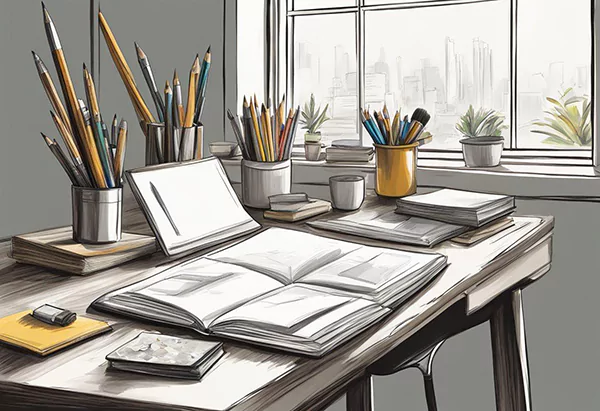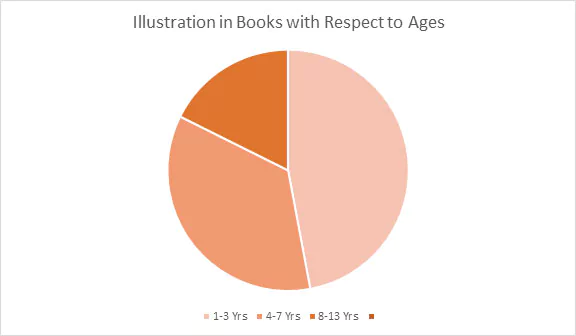Book illustrations are an indispensable component that plays an integral role in capturing the imagination and interest of young readers.
Behind every captivating image lies a thorough and meticulous process that involves several stages and tools.
From brainstorming to gathering references and inspiration, illustrators for hire bring stories to life through their illustrations.

The book illustration process starts with a well-thought-out concept.
The artist comes up with ideas, researches the topic, and gathers references and inspiration.
Once the concept is finalized, the artist moves on to sketching, where they create rough drawings to visualize their ideas. After sketching, the artist refines the drawings and adds details to create the final illustrations.
Book illustrations are not only limited to children’s textbooks. They make concepts in non-fiction publications easier to understand and add appeal and interest, making the publication more attractive to readers.
Fully illustrated non-fiction picture printer works have become a trend for kids, but illustrations are just as valuable for adult non-fiction.
Understanding its process is significant for aspiring artists who want to bring stories to life through their illustrations.
The Artistic Journey

Book illustration is a creative process that involves several stages, from conceptualizing the vision to crafting the layout and composition.
The journey begins with the author’s vision, which the illustrator brings to life through sketches and artwork.
In this section, we will take a closer look at the various stages of the artistic journey.
Conceptualizing the Vision
The first step in the artistic journey is to understand the author’s vision. This involves researching the themes, characters, and settings of the story.
A good starting point is to get motivation from different artists and award-winning picture publications.
The illustrator must also consider the target audience and ensure that the illustrations are age-appropriate and visually appealing to young readers.
According to Janice Hardy’s Fiction University, “Picture books should appeal to ages 3-8, but the age of your target audience is determined by how complex the story is and how much text is involved”.
Developing Characters and Settings
Usually, such publications have a main character that will be featured in each illustration down the line.
Once the illustrator has a clear understanding of the story’s themes and characters, they can start developing the illustrations.

Statistics:
This is the graphical representation to understand the need for illustration concerning age groups.
Let’s say, your target audience is toddlers, then your publication must have almost 80% of illustrations with big bold fonts and graphics.
This is the author’s call to what the character should look like, what color is their skin? How do they wear their hair? what does their clothing look like? and more.
This involves creating character designs that are unique and memorable, as well as designing settings that enhance the story’s mood and atmosphere.
Professionals frequently use an avatar maker to experiment with different visual styles and refine character concepts before finalising their designs. This tool allows them to quickly generate and modify avatars, ensuring that each character aligns with the story’s themes and artistic vision.
The illustrator must also consider the color palette and techniques that will be used to bring the illustrations to life.
Choosing the Right Illustration Styles
The choice of illustration style is an indispensable factor in creating a successful book.
The illustrator must consider the genre and audience of the publication and choose an appropriate style.
They must also ensure that the style enhances the emotional connection between the reader and the story.
When determining the style, there are plenty of options to choose from. For instance:
- Airbrush
- Crayon
- Comic book
- Traditional storybook
- Photo-realistic
- Vector art
- Portrait
- Watercolor
incorporating any of these styles can provide you with a better idea of what styles you like and will work for your main character.
Crafting the Layout and Composition
The final stage in the artistic journey is crafting the layout and composition of the printed work.
The illustrator must ensure that the illustrations are placed in a way that enhances the story’s visual representation.
Do You Know?:
As per the data, 58.6% of book illustrators are women and 41.4% of them are men.
They must also consider the text and ensure that the illustrations enhance and not detract from the story.
In conclusion, the artistic journey of textbook illustration involves several stages, each of which is elementary in creating a successful printed work.
The illustrator must have a clear understanding of the author’s vision, develop unique character designs and settings, choose the right illustration style, and craft the layout and composition of the book.
By following these steps, the illustrator can create illustrations that enhance the story and bring it to life for young readers.
Finalizing and Publishing
After the illustrator has completed the artwork, the next step is to refine it through feedback.
This is a required step in the book illustration process as it ensures that the artwork meets the expectations of the author and the publisher.
The illustrator should be open to feedback and willing to make necessary changes to the artwork. The feedback should be specific and constructive, highlighting areas that need improvement.
Refining Artwork Through Feedback
Getting feedback from someone to evaluate what is working and what is not working is absolutely ideal to consider before heading towards the finalization and publication.
Once the feedback has been received, the illustrator should edit and refine the artwork to address the issues raised.
Mistakes should be corrected, remove unwanted elements from our creation, and consistency should be maintained throughout the artwork.
The illustrator should collaborate with the author and the editor to ensure that the artwork aligns with the vision of the book.
Technical Aspects and Preparing for Print
Technical requirements for book illustrations vary depending on the industry and the publishing method.
Traditional publishing and self-publishing have different technical requirements, and the illustrator needs to be aware of these requirements.
The artwork should be prepared for print, and the illustrator should ensure that the final artwork meets the technical requirements.
You can also even specify multiple artboards and then choose one at a time for printing.
Marketing and Sharing With the World
Once the printed work has been published, it is important to market and share it with the world. Social media and websites such as Behance can be used to showcase the artwork and engage with the readers.
The artwork should be captivating and engaging, drawing the reader into the story. The illustrator should be proud of their work and share it with the world.
In summary, this process is a collaborative effort between the author, the illustrator, and the editor.
Interesting Fact:
The first illustrated stories go back much longer than Gutenberg’s press.
The final artwork should be engaging and captivating, drawing the reader into the story. The illustrator should be open to feedback and willing to make necessary changes to the artwork.
Technical requirements for it should be considered during the final stages of the process. Once the publication has been published, it is vital to market and share it with the world.
Conclusion

In conclusion, the book illustration process is a thorough and creative journey that requires a combination of skills, hard work, and business savvy.
It is necessary to start with a well-thought-out concept and collaborate effectively with authors and editors to ensure the success of the publication.
Throughout the process, illustrators must use their creativity and research skills to come up with ideas, gather references, and bring the story to life.
They must also navigate the publishing industry, manage contracts, deadlines, and budgets, and provide high-quality illustrations that meet the author’s vision and the story’s tone.
Illustrations can provide a visual shorthand and impart a wealth of information, thus reducing the length of the text. Therefore, it is necessary to use illustrations strategically and effectively to enhance the reading experience for the audience.
In summary, the book illustration process is a challenging yet rewarding journey that requires a combination of creativity, hard work, and business savvy.
By following the seven steps of the illustration process, illustrators can create successful illustrations that bring stories to life and captivate readers.